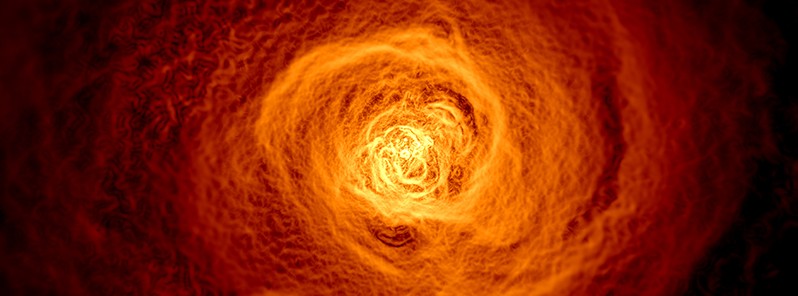X-ray ‘tsunami’ discovered in Perseus galaxy cluster

Scientists have discovered a vast wave of hot gas in the nearby Perseus galaxy cluster, spanning some 200 000 light-years. This is twice the size of our own Milky Way galaxy. The discovery was made combining data from NASA's Chandra X-ray Observatory with radio observations and computer simulations.
According to the researchers, this huge wave formed billions of years ago, after a small galaxy cluster grazed Perseus and caused its vast supply of gas to slosh around an enormous volume of space.

Galaxy clusters are the largest structures bound by gravity in the universe today. Some 11 million light-years across and located about 240 million light-years away, the Perseus galaxy cluster is named for its host constellation. Like all galaxy clusters, most of its observable matter takes the form of a pervasive gas averaging tens of millio ns of degrees, so hot it only glows in X-rays.
Chandra observations have revealed a variety of structures in this gas, from vast bubbles blown by the supermassive black hole in the cluster's central galaxy, NGC 1275, to an enigmatic concave feature known as the "bay."
To investigate the bay, researchers combined a total of 10.4 days of high-resolution Chandra data with 5.8 days of wide-field observations at energies between 700 and 7 000 electron volts. For comparison, visible light has energies between about two and three electron volts. The scientists then filtered the Chandra data to highlight the edges of structures and reveal subtle details. Next, they compared the edge-enhanced Perseus image to computer simulations of merging galaxy clusters run on the Pleiades supercomputer at NASA's Ames Research Center.
One simulation seemed to explain the formation of the bay. In it, gas in a large cluster similar to Perseus has settled into two components, a "cold" central region with temperatures around 54 million degrees Fahrenheit (30 million Celsius) and a surrounding zone where the gas is three times hotter. Then a small galaxy cluster containing about a thousand times the mass of the Milky Way skirts the larger cluster, missing its center by around 650 000 light-years.
This animation dissolves between two different views of hot gas in the Perseus galaxy cluster. The first is Chandra's best view of hot gas in the central region of the Perseus cluster, where red, green and blue indicate lower-energy to higher-energy X-rays, respectively. The larger image incorporates additional data over a wider field of view. It has been specially processed to enhance the contrast of edges, revealing subtle structures in the gas. The wave is marked by the upward-arcing curve near the bottom, centered at about 7 o'clock. Credits: NASA/CXC/SAO/E.Bulbul, et al. and NASA's Goddard Space Flight Center/Stephen Walker et al.
The flyby creates a gravitational disturbance that churns up the gas like cream stirred into coffee, creating an expanding spiral of cold gas. After about 2.5 billion years, when the gas has risen nearly 500 000 light-years from the center, vast waves form and roll at its periphery for hundreds of millions of years before dissipating.
These waves are giant versions of Kelvin-Helmholtz waves, which show up wherever there's a velocity difference across the interface of two fluids, such as wind blowing over water. They can be found in the ocean, in cloud formations on Earth and other planets, in plasma near Earth, and even on the Sun.
A paper describing the findings appears in the June 2017 issue of the journal Monthly Notices of the Royal Astronomical Society and is available online.
Featured image: This X-ray image of the hot gas in the Perseus galaxy cluster was made from 16 days of Chandra observations. Researchers then filtered the data in a way that brightened the contrast of edges in order to make subtle details more obvious. An oval highlights the location of an enormous wave found to be rolling through the gas. Credits: NASA's Goddard Space Flight Center/Stephen Walker et al.

Commenting rules and guidelines
We value the thoughts and opinions of our readers and welcome healthy discussions on our website. In order to maintain a respectful and positive community, we ask that all commenters follow these rules.